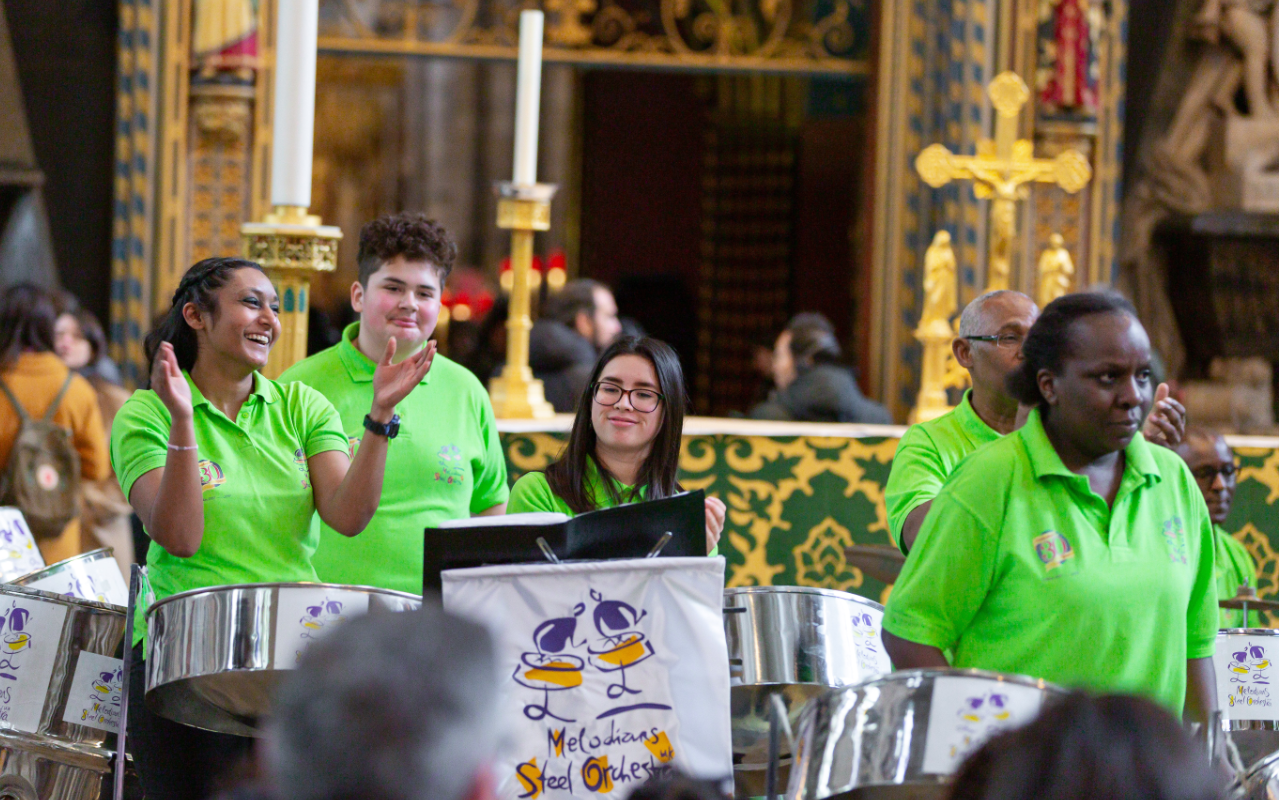
Melodians Steel Orchestra
Photo: Brendan Foster Event Photography
There are no creative ‘cold spots’
Co-creation is often about professionals ‘inviting people in’. But, as Barbara Eifler argues, communities do not need to be organised – they are already doing it for themselves.
Reading a recent article by Anne Toreggiani from the Audience Agency, I was struck by how top-down co-creation still is. It’s very laudable that professional organisations want to engage with their communities, but I can’t help feeling that this is looking at the issue back to front: somehow implicit is the assumption that only professional arts organisations know what art is and can deliver it to us, the general public.
The group I run, Making Music, is the UK association for leisure-time music with over 3,800 groups in membership, comprising around 220,000 hobby musicians. We estimate we represent around 28% of such groups. This means there are probably 13,500 in total in the UK, with 750,000 participants. And that’s just music.
Arts Council England and DCMS research Our Creative Talent from 2008 calculated, in England, 49,000 groups with 5.9 million participants. Adding numbers for Scotland, Wales and Northern Ireland proportionate to their populations, it’s likely to be 55,000 groups and 6.6 million participants, or 10% of the UK population.
Creativity invisible to the ‘counting’ eye
There’s lots going on, in every community of the UK: amateur theatre, brass bands, community choirs, water colouring, pottery, ballroom dancing, knitting clubs, folk nights, jazz events, sewing groups, and more. And this is not blink-of-the-eye-and-you-miss-it projects, this activity goes on week after week, year in year out. Some of these groups have probably been in existence for longer than the local professional arts organisation.
It therefore feels, well, a bit condescending when funders cry that there are ‘cold spots’ in the country with nothing creative going on. This is simply not true – there is plenty going on – but as it’s usually unfunded activity, it is quite often invisible to the official ‘counting’ eye.
The kinds of groups Making Music represents, and the majority of all self-organised creative community groups, are self-funded: mostly through subscriptions from their participants, supplemented by ticket sales, if relevant to their artform, with some individual fundraising – cake sales, raffles – and the occasional application to a trust, arts council or local authority.
How about this instead?
What if you went and sought out those community groups and asked them what they would like from you, and don’t assume the answer – or the first answer – will be necessarily anything artistic?
Whilst a recent survey of local groups by Creative Lives highlights the appetite for creative collaborations, it also points out that groups need help with promotion and marketing, fundraising and spaces to practise or perform their activity.
In fact, local infrastructure is what these groups need most: affordable and accessible spaces in their communities, advice on practical aspects of running a group, and upskilling as event organisers and marketers.
So how about starting there in your conversations? Perhaps it’s your PR person they need advice from first and foremost, not your artistic director. Maybe it’s box office rather than acting training they would like.
Are you listening to what your community wants?
And when such groups are looking for artistic input – and they do, as they take their activity very seriously – are you listening to what they want? Perhaps the famous ‘Pitmen Painters’, the Ashington group of miner-artists featured in the play by Billy Elliott writer Lee Hall, can point the way: they sought out a professional to teach them what they wanted to learn.
94% of Making Music’s members engage music professionals to work with them, most often a music director. They contract the person they believe is best for their group: to develop their musical skills, to make them win competitions, to take them abroad, to introduce them to new music, or the classics, or whatever their aims are as a group.
The Slaithwaite Philharmonic Orchestra, for example, produced a history of the first 100 years of its existence, which reveals it was founded by people in the Colne Valley with very varied day jobs from all sorts of socio-economic backgrounds, determined to learn about classical music, and finding the conductors to help them do that.
We have thousands of such groups in membership, choirs, ukulele groups, choral societies, jazz ensembles, community choirs, brass bands, barbershop groups, handbell ringers, amateur orchestras, drumming circles, and more, where people in their local community have come together to do something they enjoy, learn something new, develop their skill, contribute to civic life by performing in local events, raise money for charity, and make their locality a place worth living and working in.
What could professional organisations and artists do?
Don’t assume you know more than your community. Remember, they are audiences, they watch TV, go to the cinema, theatre, to museums and art galleries. Just because they’re not earning their living from performing music or acting, dancing or sculpting doesn’t mean they’re not knowledgeable about your art form. On the contrary, they are passionate about it or they wouldn’t spend so much of their leisure-time on it.
So talk to the groups in your community and find out what it is they do and how you could help them. Go to your nearest village, community or church hall and this whole world will open up to you.
Barbara Eifler is Chief Executive of Making Music.
Join the Discussion
You must be logged in to post a comment.